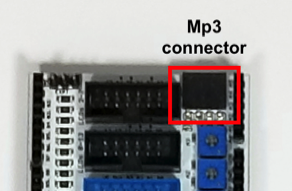This is an alternate version of the HyperDuino program for the HyperDuino that can play .mp3 or .wav files on a microSD card using a mp3 player module shown above, and which is available in the Audio Narration Add-On for the HyperDuino.
With HyperDuino_mp3 installed on the HyperDuino, each touch sensor will play one sound track when the sensor is touched.
The MP3 player module has 4 pins, labeled GND, Vcc, Tx and Rx.
Sound Files on the microSD Card
The Audio Narration Add-On includes a microSD card that has been pre-loaded with sample soundtracks that are appropriate for the example volcano project. There are also start-up sound tracks that related to the HyperDuino itself, used when the HyperDuino starts up.
One easy way of creating alternate spoken languages is to use translate.google.com, and then use a screen recorder with audio ability (or use your mobile device in a quiet environment) to capture the audio.
Note that when each directory change is made, track "001" in the folder will be played so as to provide some feedback for which folder (language) has just become active.
You can click here to download a .zip file of a sample set of audio files that are used with the volcano tutorial.
Here is a holiday model created using LEDs and the mp3 player module to play different sound tracks when sensors in the model are touched.

The upper edge of the HyperDuino has a connector with four sockets, where if you look closely, you can see the labels 5V, GND, A0 and A1.
This can be used either with or without a computer attached. When the HyperDuino is not attached to a computer, and is in the self-running mode, each touch sensor turns on a corresponding LED.
Touching sensor 13 changes the group of audio tracks used for the other sensors, so that alternate languages can be used, or other techniques such as long & short explanation, different musical sounds, etc.
With a computer attached and the HyperDuino Media Linker running, tracks will play along with whatever Internet-based media is displayed. You probably wouldn’t want sound from both the mp3 player and a video, but you might want to have music, narration or other audio accompany “silent” Internet media such as photos, maps, etc. For example, this would be a way to add narration to a Google Maps or Google Earth display.
When the HyperDuino starts up, it goes through a series of checks that determine which sound tracks will be played.
If the touch cable is already plugged in at startup, then it plays folder 00, track 002. (“Welcome to the HyperDuino” or whatever message you wish.)
If the touch cable is not already plugged in at startup, then it plays folder 00, track 000 (“Instructions to attach the touch cables”)
If the touch cable is plugged in after startup, play folder 00, track 001 (“Touch sensing now enabled”.)
Sound files on the microSD card are all in one or more folders at the first directory level of the SD card, and named "01", “02”, etc.. Files within those folders should be named "001xxxx", "002xxx", etc. where "xxx" can be any series of characters. The files can be either .mp3 or .wav files. You can replace the mp3 files on the microSD card with your own .wav or .mp3 files.
Once the HyperDuino Media Linker app starts up, automatic playback of audio tracks will still happen when you touch the sensors, but the LEDs will not automatically light. At that point, you will need to set up action list items for the different videos and other digital media as is appropriate to your project.
How to Record Sounds
For more information on how to record your own sounds for the microSD card and the mp3 player, see this section of the documentation on the Audio Narration Add-On.
Demonstrations
Here is a LEGO "Women of NASA" kit enhanced with LEDs and the mp3 player module to play different sound tracks when sensors in the model are touched.

Connect any speaker or headphone to the audio jack of the MP3 Player module.
Connecting to the HyperDuino
If you have version 2 of the HyperDuino, click here for alternate instructions.
If you have the HyperDuino+R (robotics version v4.0 or later) click here for alternate instructions.

Version 3
Version 2
Connecting to the HyperDuino (version 3)
Version 4R


Plug the mp3 module into the four sockets of the HyperDuino as shown in this photo:


HyperDuino (version 3) Audio Narration



